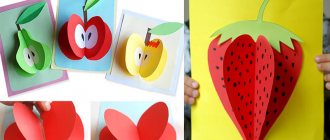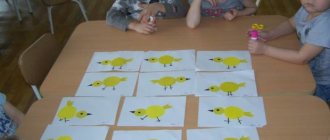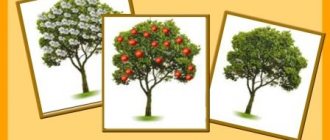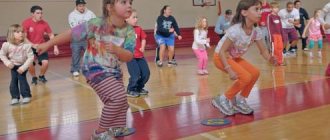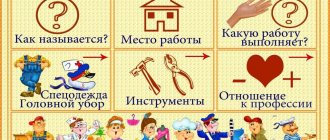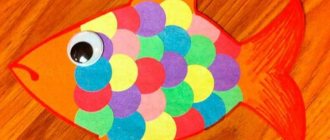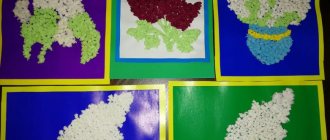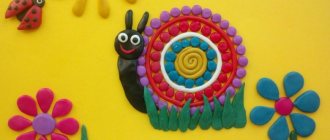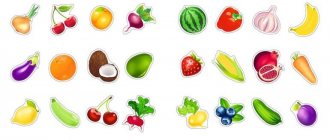Positive aspects of creating applications
This type of crafts has a very beneficial effect on the development of the child. The main advantages of creating applications:
- Development of fine motor skills of the hands;
- Development of creative and logical thinking;
- Trains perseverance and accuracy;
- While working, the baby remembers what objects look like and what they are called.
Also, in this way, a child can create not just a simple standard craft, but also present the work as a gift or interior decor.
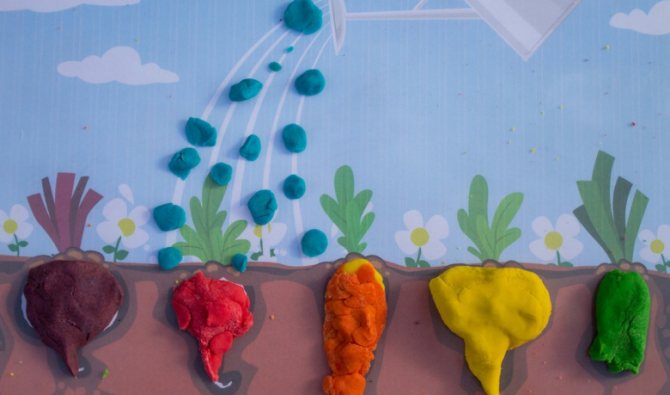
Application of geometric shapes “Fish”
Picture, black and white background and templates for work:
The principle of operation for all applications is the same: we cut out the colored templates-details and glue them onto a black and white blank.
To work you will need tools such as:
- scissors;
- PVA glue.
It is important for children to choose comfortable scissors so that they do not have any difficulties during the cutting process. Scissors should be safe, with rounded ends.
Applications fruits and vegetables
Applications in the form of fruits and vegetables are quite popular; they are created by both younger and older children. Using them you can glue real compositions, and from different materials.

The depiction of fruits and vegetables using the appliqué technique facilitates their quick learning and memorization, which is very important for a small child.
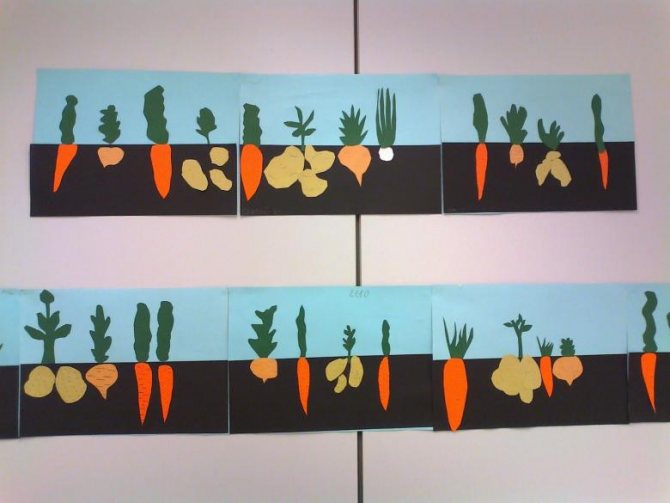
Materials for their manufacture
To make applications depicting fruits and berries, you can use not only the usual material - colored paper, but also others:
- corrugated paper;
- felt;
- some types of fabrics;
- dried tree leaves and berries;
- seeds;
- cereals and pasta;
- beads;
- eggshells;
- threads
An application on this topic with several types of materials turns out to be quite interesting and original.

Technicians
As a rule, fruits and vegetables are depicted in the form of standard applications, but they also look very interesting in 3D volume. If desired, you can make the applique using the origami technique or by twisting narrow strips of paper.
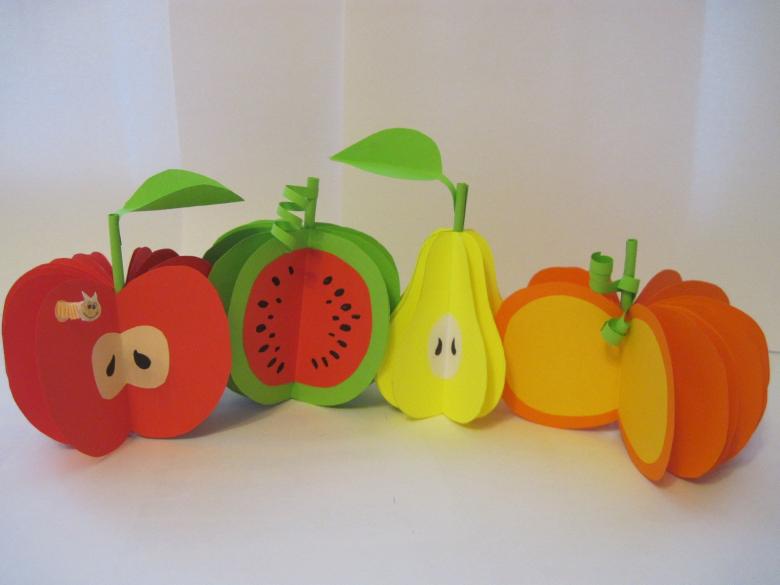
They also often do work using the mosaic technique, that is, they tear paper or break eggshells into small pieces, and then fill them with the required image.
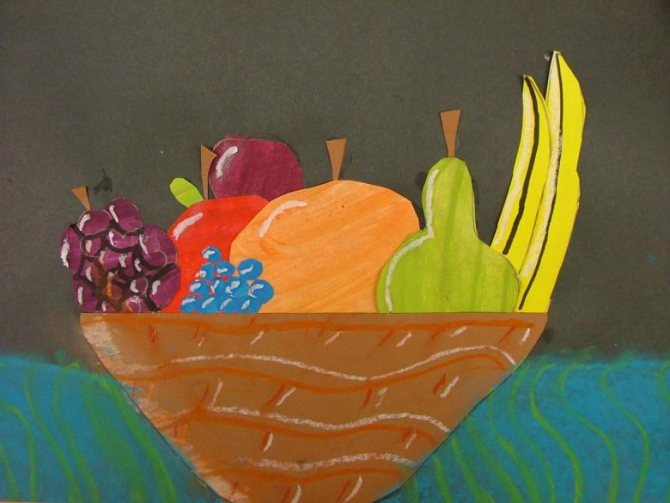
Application for children “Castle” made of colored paper
The purpose of such work is to introduce the child to such simple geometric shapes as a circle, square, rectangle, semicircle, triangle. Some patterns use more complex shapes - trapezoid, torus, rhombus, oval. The sizes and colors of the figures are also different, which introduces the baby to the concept of shape and color.
All materials are the property of the Vkusnyasha.ru portal and are protected by copyright. This material is not intended for commercial use, only for work in children's groups and at home.
For the little ones
You can start making your first applications from about 2 years old, you just have to choose the easiest and simplest options. As a rule, appliques of vegetables and fruits in a preparatory group or nursery are done in the form of a single work, rather than a composition.
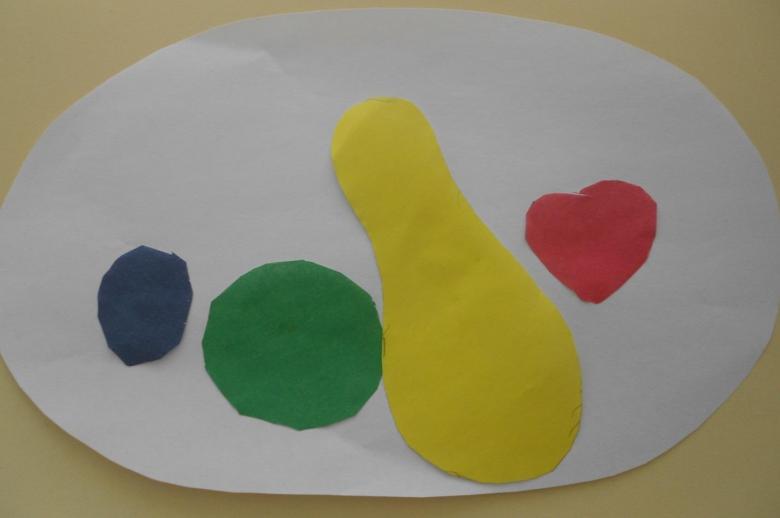
This way it is easier for children to glue them and also to remember them. To make it as easy as possible for your child, you can use already prepared templates of fruits and vegetables for appliqué.
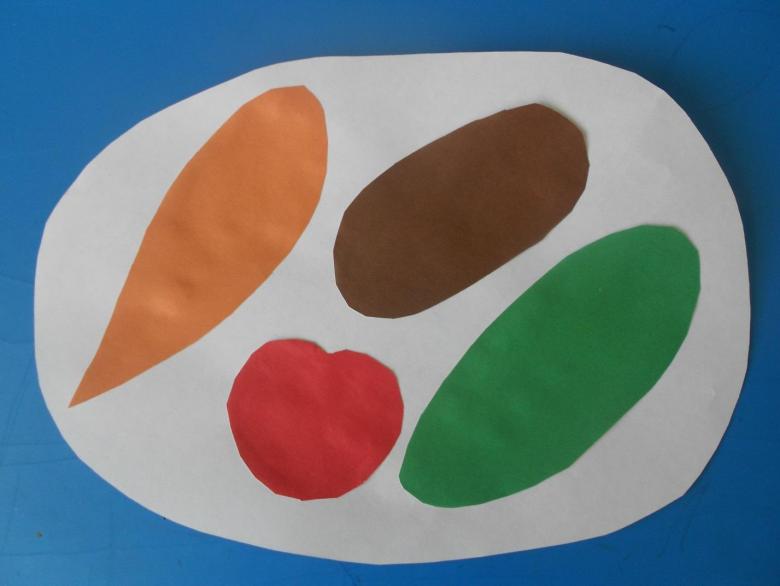
Cherry
Cherry is an excellent applique option for the youngest children on this topic. To make it you will need:
- white sheet of cardboard;
- pencil;
- scissors;
- glue;
- colored markers;
- red colored paper.
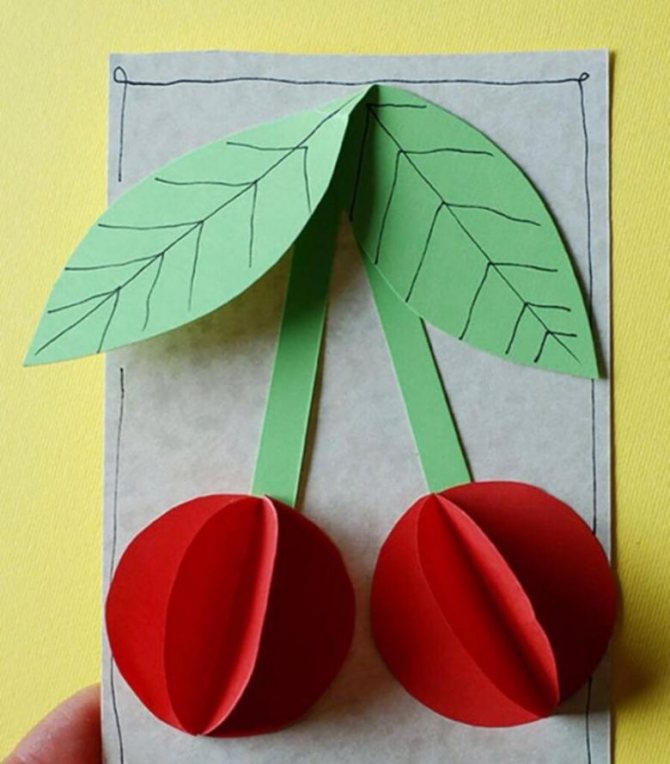
Work plan:
- Draw 2 small circles on colored paper and cut them out.
- Glue the circles onto the cardboard so that they are on the same level and not far from each other.
- Using a brown felt-tip pen, draw 2 stripes, connecting the circles to create a design in the form of a pair of cherries.
- Draw a leaf with a green felt-tip pen.

A pineapple
Almost every child likes this exotic fruit, and of course it makes them want to portray it. For a more beautiful and interesting look, you can make it voluminous from simple colored paper. All you need for this craft:
- yellow, green paper;
- sheet of cardboard;
- glue;
- scissors;
- pencil.
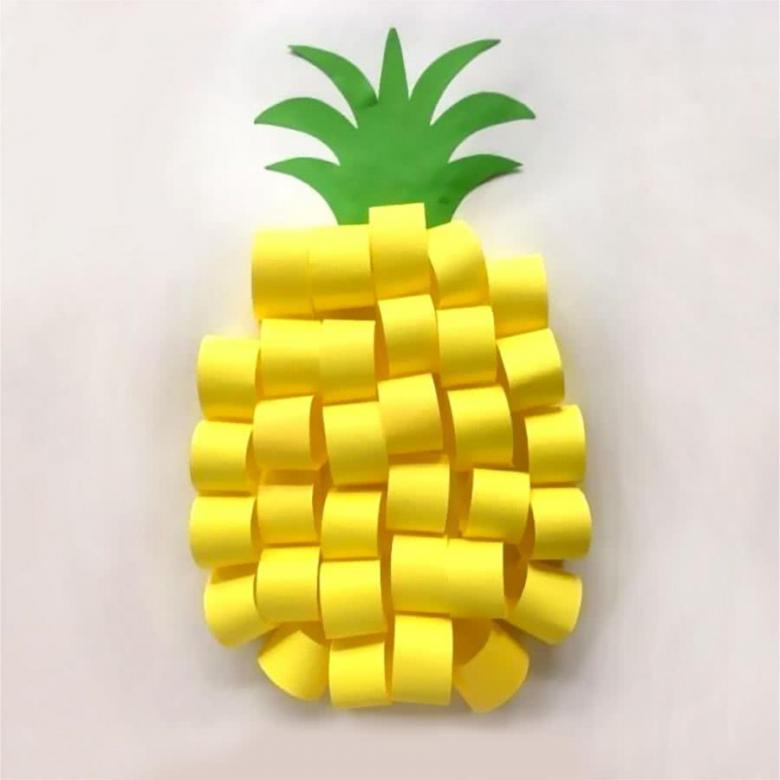
Step-by-step work plan:
- Draw a pineapple on a piece of cardboard.
- Cut the yellow paper into strips, approximately 5 cm long and 1.5-2 cm wide.
- Take one strip and fasten its ends to make a ring, glue the ends together.
- Press down a small part of the ring a little and glue it to the upper contour of the pineapple.
- Glue another ring next to it and fill the entire top row.
- Take a ring of paper and also glue it, but just below the top row of the pineapple, while the glued part should be under the free edge of the upper rings.
- Follow the previous step until the entire pineapple is filled.
- Cut out small long leaves from green paper and glue them to the top of the pineapple.
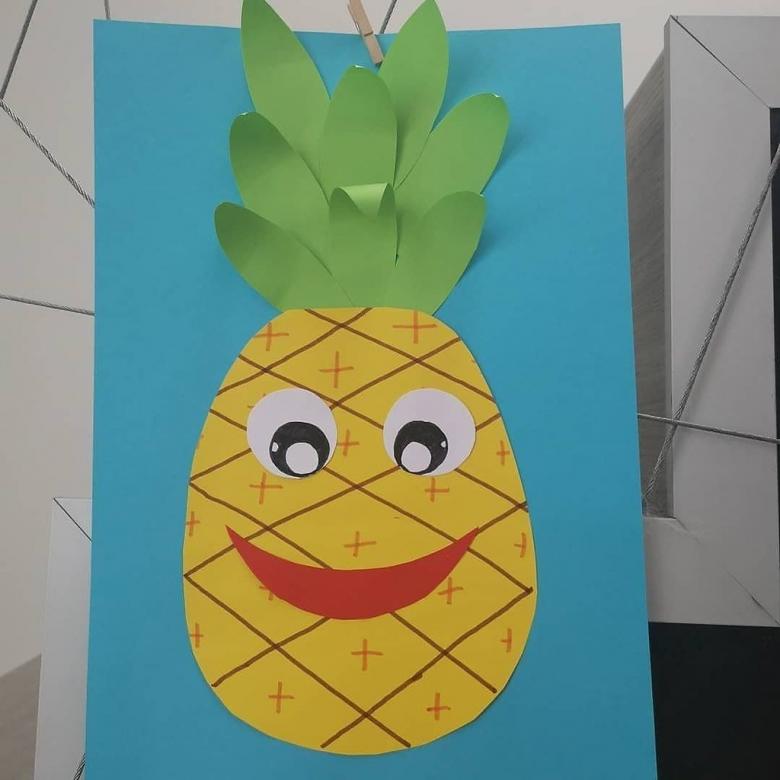
Application for children “Steam Locomotive”
You can print all the templates as on regular white paper (for copier) in A4 format, or use landscape sheets so that the parts do not wrinkle.
Fruit basket
Quite an interesting way to create a fruit applique from felt. This material is sold in a wide range of colors and is easy to work with. Also for this craft you will need: a sheet of cardboard, brown paper, scissors, a glue gun and sticks for it, a pencil, a newspaper.
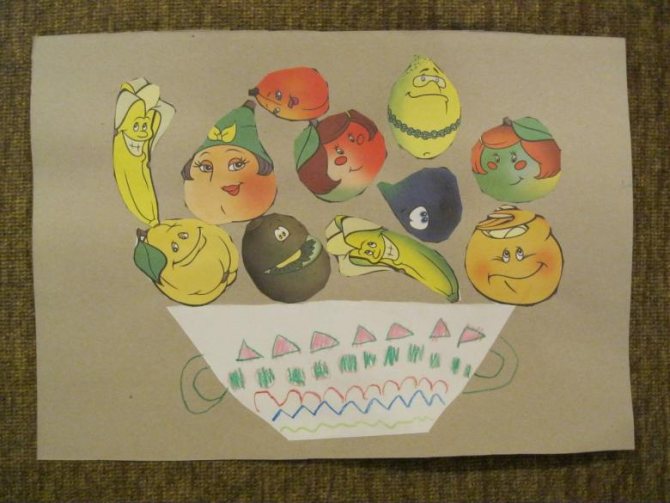
Action plan.
- Draw a basket on a sheet of cardboard.
- Cut the sheets of paper into strips about 2 cm wide and roll them into thin tubes, seal the edges well.
- Lay out the outline of the basket from newspaper tubes, cutting them to the desired size.
- Tear the brown paper into small pieces and roll them into tight balls.
- Glue the balls over the entire area of the basket, so that there is no gap between them.
- Cut out the desired fruits from felt, attach them to the basket in a happy order and glue them.
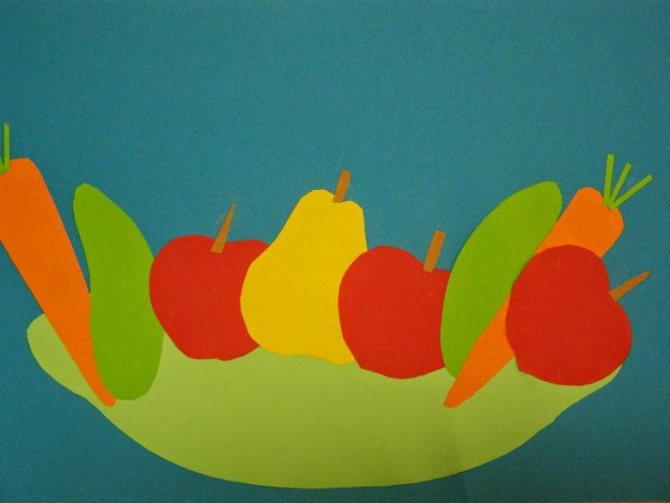
In principle, for such a volumetric application of fruits and vegetables, you can use seeds and cereals, as well as eggshells.
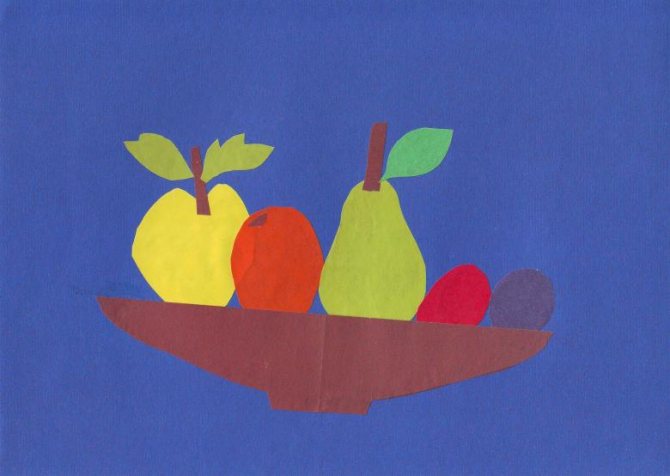
Applications depicting fruits and berries allow you to create colorful works from a variety of materials and using different techniques. Even the smallest creative hands can begin their acquaintance with appliques with vegetables, berries, fruits, and older children can create entire compositions.

Self-execution
Let's try to create a chair together. To do this we need colored paper (blue, yellow and red), a button without a needle, glue and scissors. We start from the back of the chair. Draw a shape resembling a crown on a blue sheet. We do the same on yellow, but smaller in size. Draw two orange slices on a red piece of paper. Let's move on to the legs and seat. Cut out 4 red pieces measuring 2 x 4 cm (3 pieces) and 2 x 5 cm (1 piece). We twist them into tubes and secure them with glue. We assemble a chair from the resulting material. We decorate the back with a button.
As you can see, such products look much brighter and neater. Let's look at a few sketches, having learned to draw which, you will be able to create creations with smooth, clear contours.
Let's create a TV and a sofa. We redraw them or translate them using carbon paper.
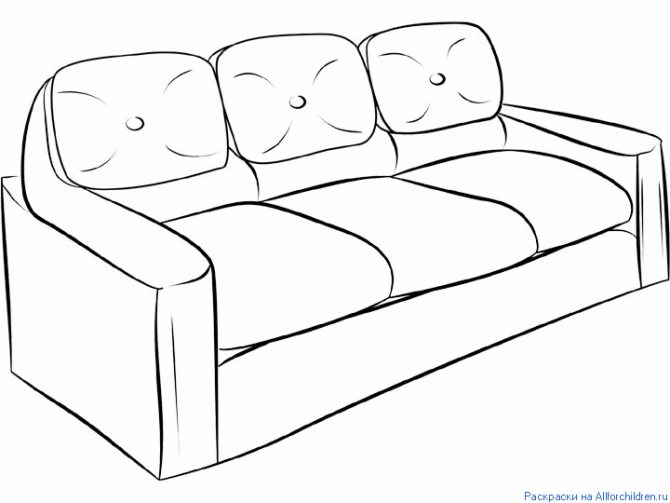
After you have drawn a sketch, color and cut out. We paste it onto the sheet in the required shape and complete the interior elements.
If you want to create a large room, then you need to draw a lot of furniture. We take a large sheet of paper or several small ones, draw a lot of different home furnishings, paint them with the necessary colors (for example, orange, blue and green). Carefully cut out with curly scissors and paste in the order we need.
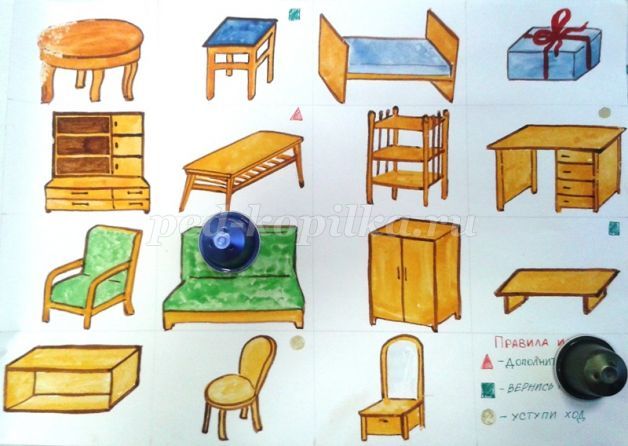
Preview:
Abstract of OOD on fine art (application) in the middle group on the topic:
- Introduce children to nature and the culture of the Bashkir people;
- Strengthen the skills of gluing the finished template, work carefully.
- To cultivate a kind, respectful attitude towards every culture of the peoples of Russia.
- Develop attention, speech, memory;
- Create an emotionally positive climate for engaging in artistic and speech activities;
- Create a friendly atmosphere in the group;
Equipment: Ready-made templates: Bashkir patterns, ornament, glue, strip of paper for each child, oilcloth, napkins.
Preliminary work: collecting information on the topic. Preparation of material and equipment. Looking at dolls in Bashkir national costumes (boy, girl).
Educator: Dear guys, today we will say hello and greet each other with our hands.
Finger gymnastics: “Greeting”
Hello, the sun is golden (spread your fingers in different directions) Hello, the sky is blue (raise your hands up)
Hello, fresh breeze (shake your raised hands)
Hello, my dear friend (join your fingers above your head, rounding your arms).
We live in our native country (spread your arms in different directions).
And I love you all (hug yourself with arms).
Children sit on chairs.
Educator: Guys, do you know what country we live in? (In Russia)
That's right, you and I live in a large, multinational country called Russia, and it has such a wonderful republic called Bashkortostan. Today we will get acquainted with the traditions and culture of the people of Bashkiria.
Educator: This amazing region is incredibly attractive with its diversity of nature. If you look at Bashkortostan from a bird's eye view, you can see mountains, valleys, rivers, lakes, and forests. Russians, Bashkirs, Tatars, Maris and people of many other nationalities live very friendly in Bashkiria. (children are shown pictures of the peoples of the Republic of Belarus).
Educator: Guys, look who came to visit us? (doll, girl).
Educator: Let's say hello to our guest. Her name is Aliya. Look what a beautiful outfit she wore. Aaliyah has a beautiful green dress with a red frill on the edge, long sleeves and a collar. A vest with a floral pattern is called a kamzul. Red boots on her feet. The head is decorated with a headband with round medallions. Aliya is Bashkir by nationality.
Educator: Guys, what do you think, is she good or evil? (children's answers).
Educator: Our guest is of a different nationality, but she is very kind, beautiful and friendly. And not only our guest is like this, the Bashkir people are all very friendly and responsive. (children look at adults in Bashkir national costumes).
Educator: Guys, do you know that the people of Bashkiria have their own customs and traditions. And they also love to dance. In the spring, when sowing work in the fields ends, the Bashkirs celebrate the folk holiday “Sabantuy”, where you can hear their favorite melodic songs about their native land and their loved ones. On this holiday, Bashkirs put on their national costumes and perform folk dances.
Educator: Guys, do you like to play? (yes). Aliya wants to play with us a little and brought us her Bashkir folk game “Kurai”. Let's play this game? (Children agree).
Outdoor game "Kurai"
The game is played: in the center of the circle there is one child, he is a kuraist, and walks in the opposite direction. Children holding hands walk in a circle. They heard our kurai and everyone gathered here. Having played enough with the kurai player, they ran off in all directions: Hai, hai, hai, hai, in the green meadow, we will dance to the kurai. (children scatter around the group) You are a cheerful chicken, play more fun, choose those who dance better. (the child kuraist chooses the best performer of the movements).
Educator: Children, we sit down in our chairs.
That's how much fun we had playing. Aliya also brought her national dishes and wants to show them to you (show pictures).
Educator: Guys, Bashkortostan is famous for its honey.
Let's find out what are the benefits of honey? (children's answers)
That's right, guys, it is medicinal and healing, strengthens the immune system.
Look, I have this barrel that Aliya brought us from the Kortatay apiary. (I show the children the barrel.)
Educator: And also, guys, our guest brought us beautiful patterns from Bashkiria.
But so that we don’t lose them, let’s stick these patterns on this carpet (sheet of paper) and keep them as souvenirs. (children's creative activity: application)
Educator: Guys, what people did we meet today? (Children's answers: Bashkirs) Who remembers what game we played? (Children's answers: Kurai)
Let's say thank you to Aliya for coming to visit us today and introducing us to her culture and traditions.
Source
